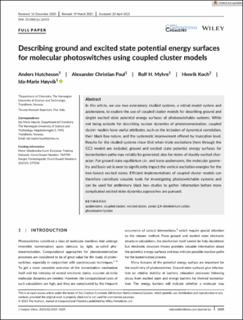| dc.contributor.author | Hutcheson, Anders | |
| dc.contributor.author | Paul, Alexander Christian | |
| dc.contributor.author | Myhre, Rolf Heilemann | |
| dc.contributor.author | Koch, Henrik | |
| dc.contributor.author | Høyvik, Ida-Marie | |
| dc.date.accessioned | 2023-11-29T11:03:59Z | |
| dc.date.available | 2023-11-29T11:03:59Z | |
| dc.date.created | 2021-08-06T10:47:39Z | |
| dc.date.issued | 2021 | |
| dc.identifier.citation | Journal of Computational Chemistry. 2021, 42 (20), 1419-1429. | en_US |
| dc.identifier.issn | 0192-8651 | |
| dc.identifier.uri | https://hdl.handle.net/11250/3105199 | |
| dc.description.abstract | n this article, we use two extensively studied systems, a retinal model system and azobenzene, to explore the use of coupled cluster models for describing ground and singlet excited state potential energy surfaces of photoswitchable systems. While not being suitable for describing nuclear dynamics of photoisomerization, coupled cluster models have useful attributes, such as the inclusion of dynamical correlation, their black box nature, and the systematic improvement offered by truncation level.
Results for the studied systems show that when triple excitations (here through the CC3 model) are included, ground and excited state potential energy surfaces for isomerization paths may reliably be generated, also for states of doubly excited character. For ground state equilibrium cis- and transazobenzene, the molecular geometry and basis set is seen to significantly impact the vertical excitation energies for the implementations of coupled cluster models can therefore constitute valuable tools for investigating photoswitchable systems and can be used for preliminary black box studies to gather information before more complicated excited state dynamics approaches are pursued. | en_US |
| dc.language.iso | eng | en_US |
| dc.publisher | John Wiley & Sons Ltd | en_US |
| dc.rights | Navngivelse-Ikkekommersiell 4.0 Internasjonal | * |
| dc.rights.uri | http://creativecommons.org/licenses/by-nc/4.0/deed.no | * |
| dc.title | Describing ground and excited state potential energy surfaces for molecular photoswitches using coupled cluster models | en_US |
| dc.title.alternative | Describing ground and excited state potential energy surfaces for molecular photoswitches using coupled cluster models | en_US |
| dc.type | Peer reviewed | en_US |
| dc.type | Journal article | en_US |
| dc.description.version | publishedVersion | en_US |
| dc.source.pagenumber | 1419-1429 | en_US |
| dc.source.volume | 42 | en_US |
| dc.source.journal | Journal of Computational Chemistry | en_US |
| dc.source.issue | 20 | en_US |
| dc.identifier.doi | 10.1002/jcc.26553 | |
| dc.identifier.cristin | 1924335 | |
| dc.relation.project | Norges forskningsråd: 263110 | en_US |
| dc.relation.project | Norges forskningsråd: 275506 | en_US |
| dc.relation.project | EC/H2020/765739 | en_US |
| cristin.ispublished | true | |
| cristin.fulltext | postprint | |
| cristin.qualitycode | 1 | |

